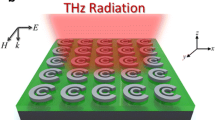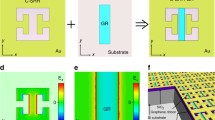Abstract
Coupling between physical modes can trigger some new physical phenomena such as frequency shift, new mode, and Rabi splitting. Resonant modes in graphene-based metamaterials provide a new platform for the research of coupling. In this work, we demonstrate that the plasmonic coupling of split ring resonator (SRR) dimer in graphene-based metamaterials can be easily manipulated. This magnetoinductive coupling can switch on/off the dark modes easily, which is usually done by symmetry-breaking structure previously. Furthermore, the dark mode can also be activated by Fermi energy as well as carrier concentration changing with either physical or chemical methods conveniently. In addition, different graphene-based SRR dimer configurations present different coupling strengths, which benefits the designing and optimizing of graphene-based metamaterials. The demonstration could enhance the versatility of both coupling studies in terahertz (THz) region and graphene-based metamaterials for THz devices.





Similar content being viewed by others
References
Khitrova G et al (2006) Vacuum Rabi splitting in semiconductors. Nat Phys 2(2):81–90
Prodan E (2003) A hybridization model for the plasmon response of complex nanostructures. Science 302(5644):419–422
Jana NR, Gearheart L, Murphy CJ (2001) Wet chemical synthesis of high aspect ratio cylindrical gold nanorods. J Phys Chem B 105(19):4065–4067
Lassiter JB et al (2008) Close encounters between two nanoshells. Nano Lett 8(4):1212–1218
Maillard M, Giorgio S, Pileni MP (2003) Tuning the size of silver nanodisks with similar aspect ratios: 65 synthesis and optical properties. J Phys Chem B 107(11):2466–2470
Hui W et al (2006) Nanorice: a hybrid plasmonic nanostructure. Nano Lett 6(4):827–832
Hao F et al (2007) Plasmon resonances of a gold nanostar. Nano Lett 7(3):729–732
Liu N, Giessen H (2010) Coupling effects in optical metamaterials. Angew Chem Int Ed 49(51):9838–9852
Luk’Yanchuk B et al (2010) The Fano resonance in plasmonic nanostructures and metamaterials. Nat Mater 9(9):707–715
Liu N et al (2009) Plasmonic analogue of electromagnetically induced transparency at the Drude damping limit. Nat Mater 8(9):758–762
Huang Y et al. (2015) Coupling Tai Chi chiral metamaterials with strong optical activity in Terahertz Region. Plasmonics 10(4):1005–1011
Novoselov K et al (2005) Two-dimensional gas of massless Dirac fermions in graphene. Nature 438(7065):197–200
Novoselov KS et al (2004) Electric field effect in atomically thin carbon films. Science 306(5696):666–669
Liu M et al (2011) A graphene-based broadband optical modulator. Nature 474(7349):64–67
Sensale-Rodriguez B et al (2012) Broadband graphene terahertz modulators enabled by intraband transitions. Nat Commun 3:780
Alaee R et al (2012) A perfect absorber made of a graphene micro-ribbon metamaterial. Opt Express 20(27):28017–28024
Nikitin AY et al (2012) Surface plasmon enhanced absorption and suppressed transmission in periodic arrays of graphene ribbons. Phys Rev B 85(8):081405
Zhu Z et al (2014) Electrically tunable polarizer based on anisotropic absorption of graphene ribbons. Appl Phys A 114(4):1017–1021
Zhou Y et al (2014) Graphene as broadband terahertz antireflection coating. Appl Phys Lett 104(5):051106
Li J et al (2014) Graphene–metamaterial hybridization for enhanced terahertz response. Carbon 78(18):102–112
Cakmakyapan S, Caglayan H, Ozbay E (2014) Coupling enhancement of split ring resonators on graphene. Carbon 80(80):351–355
Koppens FH, Chang DE, de Abajo FJG (2011) Graphene plasmonics: a platform for strong light–matter interactions. Nano Lett 11(8):3370–3377
Echtermeyer T et al (2011) Strong plasmonic enhancement of photovoltage in graphene. Nat Commun 2:458
Ju L et al (2011) Graphene plasmonics for tunable terahertz metamaterials. Nat Nanotechnol 6(10):630–634
Lee SH et al (2012) Switching terahertz waves with gate-controlled active graphene metamaterials. Nat Mater 11(11):936–941
Forouzmand A, Yakovlev AB (2015) Tunable dual-band subwavelength imaging with a wire medium slab loaded with nanostructured graphene metasurfaces. AIP Adv 5(7):077108
Wu L et al (2010) Highly sensitive graphene biosensors based on surface plasmon resonance. Opt Express 18(14):14395–14400
Christensen J et al (2011) Graphene plasmon waveguiding and hybridization in individual and paired nanoribbons. ACS Nano 6(1):431–440
Ishikawa A, Tanaka T (2013) Plasmon hybridization in graphene metamaterials. Appl Phys Lett 102(25):253110
Fang Z et al (2013) Gated tunability and hybridization of localized plasmons in nanostructured graphene. ACS Nano 7(3):2388–2395
Grigorenko A, Polini M, Novoselov K (2012) Graphene plasmonics. Nat Photonics 6(11):749–758
Qi M et al (2014) Improving terahertz sheet conductivity of graphene films synthesized by atmospheric pressure chemical vapor deposition with acetylene. J Phys Chem C 118(27):15054–15060
Choi H et al (2009) Broadband electromagnetic response and ultrafast dynamics of few-layer epitaxial graphene. Appl Phys Lett 94(17):172102
Dawlaty JM et al (2008) Measurement of the optical absorption spectra of epitaxial graphene from terahertz to visible. Appl Phys Lett 93(13):131905
Zhou Y et al (2013) Tunable magnetoplasmons for efficient terahertz modulator and isolator by gated monolayer graphene. Phys Chem Chem Phys 15(14):5084–5090
Winnerl S et al (2011) Carrier relaxation in epitaxial graphene photoexcited near the Dirac point. Phys Rev Lett 107(23):237401
von Cube F et al (2013) From isolated metaatoms to photonic metamaterials: evolution of the plasmonic near-field. Nano Lett 13(2):703–708
Liu N, Kaiser S, Giessen H (2008) Magnetoinductive and electroinductive coupling in plasmonic metamaterial molecules. Adv Mater 20(23):4521–4525
Liu N, Giessen H (2008) Three-dimensional optical metamaterials as model systems for longitudinal and transverse magnetic coupling. Opt Express 16(26):21233–21238
Liu N et al (2009) Stereometamaterials. Nat Photonics 3:157–162
Dong Z-G et al (2010) Plasmonically induced transparent magnetic resonance in a metallic metamaterial composed of asymmetric double bars. Opt Express 18(17):18229–18234
Cao W et al (2012) Low-loss ultra-high-Q dark mode plasmonic Fano metamaterials. Opt Lett 37(16):3366–3368
Randall C, Rawcliffe R (1967) Refractive indices of germanium, silicon, and fused quartz in the far infrared. Appl Opt 6(11):1889–1895
Smith D et al (1985) Handbook of optical constants of solids. Handb Opt Constants Solids 1:369–406
Falkovsky L (2008) Optical properties of graphene. J Phys: Conf Series. IOP Publishing 129(1):012004
Ding J et al. (2014) Tuneable complementary metamaterial structures based on graphene for single and multiple transparency windows. Sci Reports 4:6128
Hanson GW (2008) Dyadic Green’s functions and guided surface waves for a surface conductivity model of graphene. J Appl Phys 103(6):064302
Papasimakis N et al (2013) The magnetic response of graphene split-ring metamaterials. Light: Sci Appl 2(7), e78
Kuzmenko A et al (2008) Universal optical conductance of graphite. Phys Rev Lett 100(11):117401
Li Z et al (2008) Dirac charge dynamics in graphene by infrared spectroscopy. Nat Phys 4(7):532–535
Low T, Avouris P (2014) Graphene plasmonics for terahertz to mid-infrared applications. ACS Nano 8(2):1086–1101
Hanson GW (2008) Quasi-transverse electromagnetic modes supported by a graphene parallel-plate waveguide. J Appl Phys 104(8):084314
Linden S et al (2004) Magnetic response of metamaterials at 100 terahertz. Science 306(5700):1351–1353
Enkrich C et al (2005) Magnetic metamaterials at telecommunication and visible frequencies. Phys Rev Lett 95(20):203901
Corrigan T et al (2008) Optical plasmonic resonances in split-ring resonator structures: an improved LC model. Opt Express 16(24):19850–19864
Zhang J et al (2014) Tailoring alphabetical metamaterials in optical frequency: plasmonic coupling, dispersion, and sensing. ACS Nano 8(4):3796–3806
Wen X, Zheng J (2014) Broadband THz reflective polarization rotator by multiple plasmon resonances. Opt Express 22(23):28292
Hwang E, Adam S, Sarma SD (2007) Carrier transport in two-dimensional graphene layers. Phys Rev Lett 98(18):186806
Horng J et al (2011) Drude conductivity of Dirac fermions in graphene. Phys Rev B 83(16):165113
Fan Y et al (2013) Enhancing infrared extinction and absorption in a monolayer graphene sheet by harvesting the electric dipolar mode of split ring resonators. Opt Lett 38(24):5410–5413
Ouyang Y et al (2006) Comparison of performance limits for carbon nanoribbon and carbon nanotube transistors. Appl Phys Lett 89(20):203107
Acknowledgments
This work was supported by the National Natural Science Foundation of China (No. 11374240, No. 61265005), Ph.D. Programs Foundation of Ministry of Education of China (No. 20136101110007), Key Laboratory Science Research Plan of Shaanxi Education Department (13JS101), and National Key Basic Research Program (2014CB339800).
Author information
Authors and Affiliations
Corresponding author
Rights and permissions
About this article
Cite this article
Huang, Y., Yao, Z., Hu, F. et al. Manipulating Magnetoinductive Coupling with Graphene-Based Plasmonic Metamaterials in THz Region. Plasmonics 11, 963–970 (2016). https://doi.org/10.1007/s11468-015-0130-0
Received:
Accepted:
Published:
Issue Date:
DOI: https://doi.org/10.1007/s11468-015-0130-0




